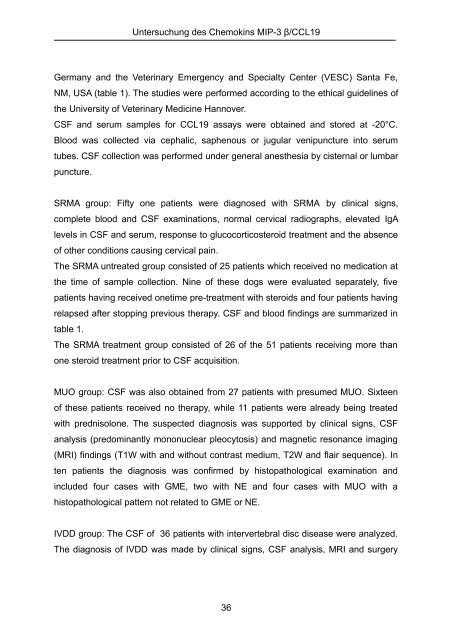TiHo Bibliothek elib - Tierärztliche Hochschule Hannover
TiHo Bibliothek elib - Tierärztliche Hochschule Hannover
TiHo Bibliothek elib - Tierärztliche Hochschule Hannover
You also want an ePaper? Increase the reach of your titles
YUMPU automatically turns print PDFs into web optimized ePapers that Google loves.
Untersuchung des Chemokins MIP-3 β/CCL19<br />
Germany and the Veterinary Emergency and Specialty Center (VESC) Santa Fe,<br />
NM, USA (table 1). The studies were performed according to the ethical guidelines of<br />
the University of Veterinary Medicine <strong>Hannover</strong>.<br />
CSF and serum samples for CCL19 assays were obtained and stored at -20°C.<br />
Blood was collected via cephalic, saphenous or jugular venipuncture into serum<br />
tubes. CSF collection was performed under general anesthesia by cisternal or lumbar<br />
puncture.<br />
SRMA group: Fifty one patients were diagnosed with SRMA by clinical signs,<br />
complete blood and CSF examinations, normal cervical radiographs, elevated IgA<br />
levels in CSF and serum, response to glucocorticosteroid treatment and the absence<br />
of other conditions causing cervical pain.<br />
The SRMA untreated group consisted of 25 patients which received no medication at<br />
the time of sample collection. Nine of these dogs were evaluated separately, five<br />
patients having received onetime pre-treatment with steroids and four patients having<br />
relapsed after stopping previous therapy. CSF and blood findings are summarized in<br />
table 1.<br />
The SRMA treatment group consisted of 26 of the 51 patients receiving more than<br />
one steroid treatment prior to CSF acquisition.<br />
MUO group: CSF was also obtained from 27 patients with presumed MUO. Sixteen<br />
of these patients received no therapy, while 11 patients were already being treated<br />
with prednisolone. The suspected diagnosis was supported by clinical signs, CSF<br />
analysis (predominantly mononuclear pleocytosis) and magnetic resonance imaging<br />
(MRI) findings (T1W with and without contrast medium, T2W and flair sequence). In<br />
ten patients the diagnosis was confirmed by histopathological examination and<br />
included four cases with GME, two with NE and four cases with MUO with a<br />
histopathological pattern not related to GME or NE.<br />
IVDD group: The CSF of 36 patients with intervertebral disc disease were analyzed.<br />
The diagnosis of IVDD was made by clinical signs, CSF analysis, MRI and surgery<br />
36










![Tmnsudation.] - TiHo Bibliothek elib](https://img.yumpu.com/23369022/1/174x260/tmnsudation-tiho-bibliothek-elib.jpg?quality=85)





